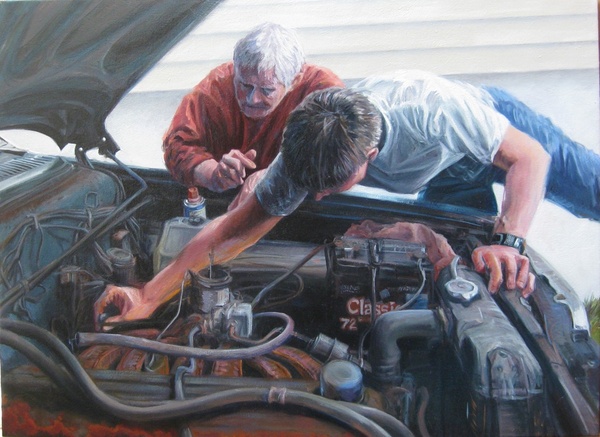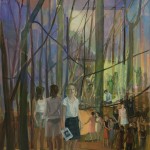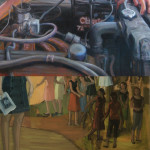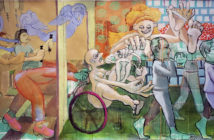It could happen.
Lizi Brown’s Butch dykes could drop their wrenches, drink from a little bottle that says “drink me,” shrink to doll scale and wander over to the suburban bonfire in one of Vera Iliatova’s teenscapes. Or vice versa, Iliatova’s girls could change clothes at the Dickies Store, inflate and crowd around the open hood of the Valiant and strain to focus. Not that this would accomplish much, since the girls would just get bored and the dykes would get sleepy. This is easy to predict, because both Brown and Iliatova present such complete visual worlds their characters feel familiar. While the worlds they depict may be near opposites, both Brown and Iliatova have something unique to say about women and about painting.
Let’s sober up and return to the spell of each painter individually, starting with Brown. The unconventional installation sets the tone for Slant Six: 19 paintings of varying sizes from small framed gouaches to large un-stretched canvases that wrap around two walls of the Foster Gallery, in the MFA. This is risky, but consistent with Brown’s “down to earth” aesthetic, and the little gouaches are as wonderful as the larger canvases. The effect is of being surrounded by the couple, Woody and Peg, as they spend an afternoon working on their classic car, a ’66 Dodge Valiant.
Although they are everywhere and close-up, Woody and Peg are usually cropped, and barely contained within the picture as they bend over the car, crawl under it, or get a tool. The oblique yet close focus views of the women make you feel as if you’re standing in the driveway with them. In contrast to the slivers of Woody and Peg, the engine is propped open like a treasure chest of tanks and cylinders. You can really feel the paint moving through the engine parts as Brown draws and wipes away to the ground. Brown loves paint and has a beautiful touch, but every mark and color must evoke a piece of Woody and Peg’s reality: the red of a sweatshirt or twist of a wrist. Wish there was a moment when the stroke ignored the picture, a’ la Cecily Brown? Maybe, but that wouldn’t be butch, and after looking at Lizi Brown’s painting for awhile, the other Brown might feel contrived.
Actually, as I stood in front of Brown’s work, Winslow Homer came to mind. One Homer's reoccurring subjects featured women in the midst of domestic tasks (as in the stereotype of what was considered "women's work"). Brown manages to twist that that convention by engaging women working on what is seen the quintessential American pastime. It seems like a quiet miracle that Brown’s images of older dykes fixing cars could become part of “the American scene.”
Now let’s turn our attention to the secret and self absorbed world of teenage girls in Vera Iliatova’s paintings (which were recently on view at LaMontagne Gallery in South Boston. The largest of the six paintings reminded me of Ambrogio Lorenzetti’s Allegory of Good and Bad Government, in that they are macrocosmic landscapes with architecture teeming with little figures. But in the case of Hotel Bleu or Rules and Games the people are exclusively teenage girls, the architecture is modernist, and the landscape is puzzlingly a thicket of forested suburbia. Iliatova’s work is so full of contradictions that it is hard to say what time of day it is, what season it is, where are these girls? School? Rehab? An elite villa district?
In Star, three impossibly large girls occupy the immediate foreground of some indeterminate group activity in the forest. One of the girls has her back to the viewer and is wearing a see-through dress, while the one facing us is dressed rather prudishly in white blouse and black skirt: a prep school or waitress uniform? The girl clutches a photograph and looks dazedly out of the painting. She is one of Iliatova’s largest and most expressive figures, but is she tragically devastated or blissfully infatuated? Because of the flashes of light, the concentration of people, and the floating screen shape, this might be a concert or a film shoot- but there isn’t a stage and there aren’t any cameras. These collage-like contradictions create an open -ended narrative in which multiple interpretations are possible.
Although it is fun to imagine what the girls are up to, the overall mood of the paintings is not cheerful. Despite the glowing mangos and pretty purples radiating from the underpainting, the vertical trees, the disassociated cliques, and the cold buildings create a melancholy atmosphere. Layering details with opaque paint over large washes of color creates a sparkle and luminosity at odds with the angsty scenes.
In an era of figure painting in which John Currin, Lisa Yuskavage, and Philip Pearlstein dominate with images of the female nude, it’s refreshing to see painters like Brown and Iliatova mine new territory. Being young, being media obsessed for Iliatova, being middle aged, being gay for Brown. The backgrounds are so important to these painters. Peg and Woody are inseparable from the Valiant just as Iliatova’s girls need their forests and bunkers. It’s not enough just to present new female characters, for Brown and Iliatova it has to be a new world.
- Lizi Brown, from the series Slant Six, oil on canvas. 2010, 28×38”
- Vera Iliatova, Star, oil on canvas, 2009/2010, 50×40″
- Detail of brushwork of both Lizi Brown (top), and Vera Iliatova (bottom)
Museum of Fine Arts, Boston
LaMontagne Gallery
Lizi Brown is now on view as part of the 2010 Traveling Scholars Exhibition at the Museum of Fine Arts, Boston (465 Huntington Ave.) through May 31st; Vera Iliatova was on view (withTory Fair) until until May 8th, LaMontagne Gallery, located at 555 East 2nd Street, South Boston, MA.
All images are courtesy of the artists and the Museum of Fine Arts, Boston, and LaMontagne Gallery.







